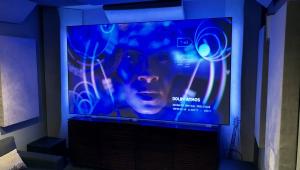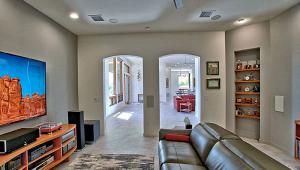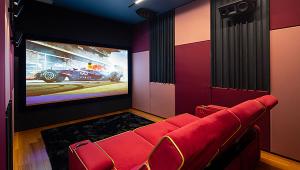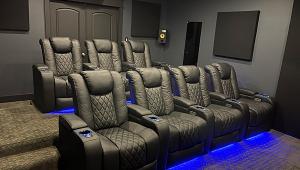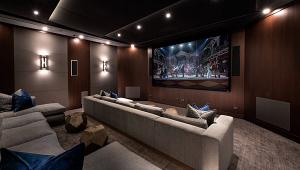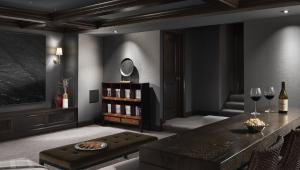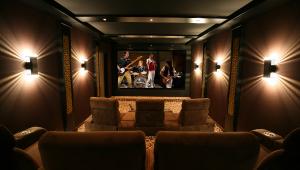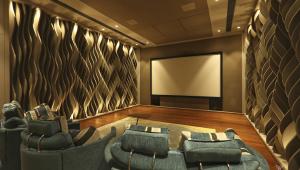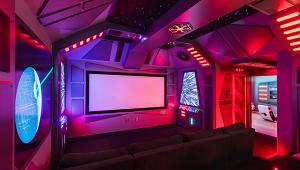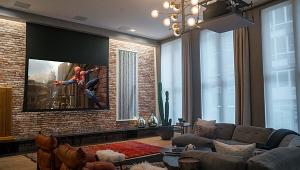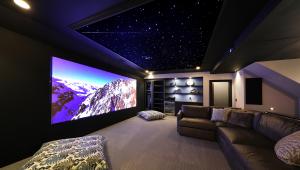Demonstrating Your Home Theater System, Part I
Part I: How to impress your family and make your neighbors jealous.
After dreaming for years, you finally acquired that home theater you've always wanted. Guided by a little help from your not-so-subtle hints, Santa delivered to you a 60-inch plasma television, a Blu-ray player, a high-definition cable box (complete with a built-in digital video recorder), a speaker system, a killer sub, and a new, powerful 7.1-channel receiver. Admittedly, you bought some of them yourself, but it's the thought that counts, right?

A proper speaker setup.
Best of all, you received the blessing of your spouse to take over the basement. OK, so you had to agree to relegate the drill press and the radial saw to the garage. However, in exchange for that painful move, you are now the newly self-appointed CEO (Chief Entertainment Officer) of this veritable fortress of picture and sound.
But now, how do you challenge that new cineplex that just opened at the mall? More importantly, how do you convince your spouse that it was a great investment? And finally, how do you make your next-door neighbor (the one with the coffin-sized subwoofer that blurts out nothing but bloated, one-note bass) green with envy?
Well, in the pages to follow, I'm going to help you develop and present an incredible demo for your home theater. And, in the end, you'll have the admiration of your family and friends, not to mention a healthy new respect from your neighbor in all things home theater. Be prepared to become the local A/V guru.
The secrets revealed here were gathered by several of us who have worked in the home theater industry for the last two decades. We have learned that there are many rules to follow and, of course, some to be broken. Collectively, we have put together hundreds of home theater setups and conducted well over 2,000 demonstrations. Not only have we discovered what works, we've also found what totally misses the mark.
A good demonstration should leave the viewers smiling, laughing, crying, in awe, or just plain breathless from the full experience. For just a brief period of time, the best demos will take your audience to a different place, a place where they are not thinking about the system. They are totally immersed in what they see and hear. It's only then that a good demonstration has done its job.
We have all seen and heard otherwise good home theater demonstrations fail simply because of plain old poor setup. If it's too loud (that's right, not a misprint) or has too much bass or too much surround, the entire experience can be disappointing. The only thing your audience will be thinking is, "When will this be over?" So here, for your viewing and listening pleasure, is a crash course in home theater acoustics.

Peter Tribeman in full demo action.
The Rules of the Setup: Dead Is Better Than Live
Have you ever spoken on the phone with friends and it seems as if they're talking to you from a small gym? Chances are, they're speaking from a beautiful living room with hardwood floors, high ceilings, and large picture windows. While it looks great, it's a haven for reflected sounds. When you are visiting them in person, you find it difficult to understand a conversation in their living room unless you are only a few feet away from the person speaking. The sonic reflections from the walls, ceiling, floors, and windows mix with the voices and hamper intelligibility.
But if your friends decorated their living room with some draperies and rugs, all of a sudden, you would easily understand the conversation. The material would absorb some sound reflections, and you would be able to easily understand the conversation.
In the same way, a good home theater incorporates different sound-absorbing materials that kill some of the spurious reflections. It doesn't mean that you have to erect an anechoic chamber; too much absorption isn't optimal, either. But absorbing some of those nasty reflections will work miracles for intelligibility, especially in the center channel. Believe it or not, the key to having a really good home theater is a high degree of center-channel clarity. Just think of how many movies you've watched when you could not understand important parts of the dialogue. That alone can ruin an otherwise great movie.
How do you know if you need to damp out some of the reflections in your room? The answer is easy. Just clap your hands once and listen. If you can hear that sound gradually die away, or hear a quickly bunched set of little echoes, you have a problem. Add rugs, bookshelves (with books), small wall hangings, or tapestries until most of the reflections disappear. Find someone to stand where the center channel will be located and ask him or her to speak to you in a normal conversational voice. If you can understand every word, you are in pretty good shape.

Acoustic panels can be a lifesaver.
Getting Your Speaker Setup in the Right Shape
Left/Right Speakers: Sometimes Wide-Open Spaces Are Bad
Your front speakers should be wide enough apart to deliver a convincing soundstage for both music and movies. However, they should not be spread too far apart, or else an acoustic hole will develop in the middle when you play two-channel music. The best way to test this is to listen to vocals and music separately. The vocals should be perfectly centered between the left and right speakers. However, when listening to music, if the instruments don't create a convincing soundstage in front of you, that is a clue that you have them set too far apart. Move both speakers in until the stage melds seamlessly. If possible, and recommended by the speaker's manufacturer, you should toe in the left and right speakers a little toward the main listening position.
- Log in or register to post comments
